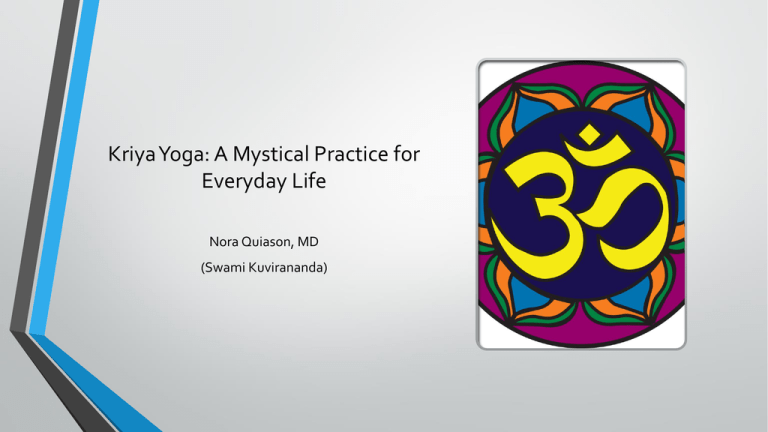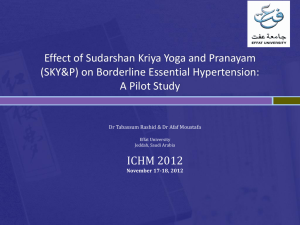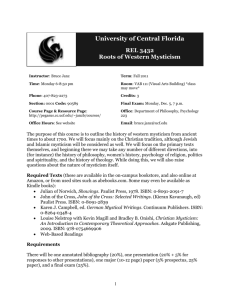
Kriya Yoga: A Mystical Practice for
Everyday Life
Nora Quiason, MD
(Swami Kuvirananda)
Outline
• Part One
1. Mysticism
2. Kriya Yoga
3. Mystical and Kriya Yoga Concepts
•
•
•
•
•
•
Immortality
Dharma
Karma
Death and Rebirth
Aham Brahmasme
Kali Yuga: the Present Age
The Eight Limbs of Yoga
Patanjali’s Yoga Sutras
• Part Two: Daily Practice and Rituals
1. Yama (Abstentions)
2. Niyama (Observances)
3. Asanas (Yoga Postures)
4. Pranayama (Breath Control)
5. Pratyahara (Withdrawal of the Senses)
6. Dharana (Concentration)
7. Dhyana (Meditation)
8. Samadhi (Contemplation)
Mysticism
• Derived from the Greek meaning to conceal and from the word mystikos
meaning an initiate.
• “The pursuit of communion with, identity with, or conscious awareness of
an ultimate reality, divinity, spiritual truth, or God through direct
experience, intuition, instinct or insight.” WF Cobb, Mysticism and Creed,
1914
Perennial Philosophy
Aldous Huxley
“the metaphysic that recognizes a divine Reality substantial in the world of things and
lives and minds; the psychology that finds in the soul something similar to, or even
identical with divine Reality; the ethic that finds man’s final end in the knowledge of
the immanent and transcendent Ground of all being is immemorial and universal.”
“Rudiments of the Perennial Philosophy may be found among the traditionary lore of
primitive peoples in all regions of the world, and in its fully developed forms it has a
place in every one of the higher religions.”
Some Mystical Traditions
•
•
•
•
•
•
Kabbalah- Jewish mysticism- esoteric practice meant to connect the finite material universe with an eternal ultimate
reality.
Sufism- Islamic mysticism- teaches turning the heart away from all else but God
Buddhism- mystical practice teaching the impermanence of all creation and dependent origination (There is no such thing
as independent existence)
Christian mysticism- various practices which brings the mystic into the realization of his creator God: Gnosticism,
Rosicrucian
Toltec mysticism- Carlos Castaneda, Don Miguel Ruiz
Other traditions: Native American, Australian aboriginal traditions
Mystical experience is very personal and unique and therefore, beyond
description.
To the critical thinker, therefore, mystical experience is suspect.
Criticisms of Mysticism
The mystic works from within as opposed to the philosopher who works from
without. “The mystic starts from his inner, positive, individual experience, in
which he finds himself as the eternal and only being…But nothing of this is
communicable except that we have to accept the assertions that we have to
accept his word.
Schopenhauer, The World as Will and Representation
Criticisms of Mysticism
•
Mystical experiences only seem profound and persuasive because the mind’s
critical faculties are inactive.
Martin Minsky
•
Mystical experience is essentially an infantile regressive experience and what is
perceived as experience of oneness is actually the memory of oneness with the
mother in the womb.
Freud
Criticisms of Mysticisms
• “Mysticism is the acceptance of allegations without evidence or proof,
either apart from or against the evidence of one’s senses and one’s reason.
Mysticism is the claim to some non-sensory, non-rational, non-definable,
non-identifiable means of knowledge, such as ‘instinct,’ ‘intuition,’
‘revelation,’ or any form of ‘just knowing.’
• Ayn Rand, Faith and Force: The Destroyer of the Modern World
Mysticism
At some point we come to question the purpose of life and when we do, we find that
the promise of a heaven or a threat of a hell no longer satisfactorily informs our
judgments.
“You must make haste to do your work here, for it is here that you can truly do
it….Expect nothing from death. Life is your only salvation…It is in life that you must
transform yourself. It is upon earth that you progress and it is upon earth that you
realize. It is in the body that you win the Victory.”
The Mother (Questions and Answers, MCW Vol. 3, p. 198)
Mysticism
Shakyamuni Buddha taught that human birth is as rare as the likelihood of a blind
turtle rising from the depths of the ocean once in a hundred years and putting his
head into the hole of a fisherman’s yoke.
Buddhists believe that one’s present condition as a human should be highly valued.
“Instead of feeling so much regret when we lose our money, we should develop regret
when we waste our human life.” Pabongka Rinpoche
Mysticism
Confucius: Espoused the sublime perfection of the Chun Tzu, the Superior Man (man who embodies the best
qualities of humankind)as the ideal by which each person should aspire. Only when society is filled with many
Chun Tzu, can the world then move towards peace.
•
•
Jen: Embodies the concept of goodness, benevolence and love, and its external expression. The Jen is the
inner ideal of the dignity of human life wherever it exists, thus the simultaneous respect for oneself and the
feelings of love for and connectedness with others. It embodies empathy and the desire to affirm oneself
while affirming others. The Jen endowed man is benevolent and loving towards all everywhere because he
knows “within the four seas all men are brothers and sisters.”
Li: The Li is the external expression of the Jen, which entails social propriety. When everyone becomes
idealized with Jen and performs their duties with Li, life and society flows in harmony
Mysticism
“Seeing into darkness is clarity, knowing how to yield is strength.
Use your own light and return to the source of light. This is called practicing
eternity.”
Chapter 32 Tao Te Ching
Mysticism
•
•
•
•
Mystical practices are navigational tools in the journey to find the self. It allows
one “to live in this world but to not be of this world.”
There are no sad saints. Life is good.
Through mystical practice, we can appreciate all that is good and beautiful in all of
creation and align the stream of our lives in the flow of universal life.
When we understand this, we can face any adversity and good fortune alike with
equanimity.
Kriya Yoga
•
Kriya from the Sanskrit “kri” meaning action and “ya” meaning awareness
•
Kriya- action with awareness
•
Yoga from the Sanskrit “yug” meaning to yoke, to bind or to harmonize
•
Kriya yoga is a mystical practice which provides a way to expand one’s horizon of
awareness, to live life deliberately and to harmonize one’s life into the flow of universal life.
Kriya Yoga
• It is a mystical practice derived from teachings of ancient sages called
“rishis” whose knowledge was passed on through oral tradition over
centuries and eventually codified at around 500 CE.
• It is not a religion and is compatible with other spiritual practices.
• It emphasizes self-discipline through a series of practices and rituals that the
aspiring yogi does daily in order to gain wisdom.
Kriya Yoga
“ Yoga is a path of individual
Enlightenment
•
•
•
•
In its most practical meaning, enlightenment is nothing more than spiritual
maturity.
The way to spiritual maturity is to know the self as it really is.
The true self cannot be known through the external senses but only through
processes of turning inward where the mind is still.
Zen Buddhism: The way to enlightenment- “Chop wood, carry water.” We find
enlightenment as well in the way we conduct or day to day responsibilities.
Immortality
•
You have been present since beginningless time and will continue to be, through
endless time.
• Your are spirit travelling through time in a body and a mind.
• You are not a body with a mind and perchance, a spirit/ soul.
“The atman (soul, spirit) is never born and he never dies, nor does he repeatedly come
into being and undergo expansion, because he is unborn and eternal.
He is inexhaustible ever-youthful yet ancient. Although the body is subject to birth
and death, the atman is never destroyed.” Bhagavad Gita
What is immortal?
•
•
Buddhism: Substrate consciousness
Buddhist accounts of the substrate consciousness all refer to it as an individual
stream of consciousness that carries on from one lifetime to the next.
• Bavangha: meaning “ground of becoming” Theravadan Buddhist view of a vacuum
state of consciousness devoid of mental activity, accessible in the meditative state,
during sleep and at the time of death.
• Substrate consciousness is sort of the undifferentiated stem cell of consciousness
which returns to the void at the time of death and is passed on to the next lifetime.
B. Alan Wallace: Vacuum States of Consciousness: A Tibetan Buddhist View
What Is Immortal?
•
•
•
Christianity: Soul
“The soul may be defined as the ultimate internal principle by which we think, feel,
and will, and by which our bodies are animated…. If there be a life after death,
clearly the agent or subject of our vital activities must be capable of
an existence separate from the body. The belief in an animating principle in some
sense distinct from the body is an almost inevitable inference from the observed
facts of life.”
Catholic Encyclopedia
What Is Immortal?
• Islam: Ruh (spirit) and Nafs (soul)
Although used interchangeably, nafs is generally used to mean soul when it is
in the body while ruh refers to the soul when it is outside the body.
What Is Immortal?
Advaita Vedanta: Hindu thought of non-duality- that the Self (atman) is not separate from the Whole (Brahman) (Adi
Shankara)
“That thou art.”
Brahman is the only truth, the spatio-temporal world is only an illusion, and there is ultimately, no difference between
Brahman and the atman (individual self.)
The Vedantas predate the Bible. This concept of the individual self being one with Brahman (God) is contained in the biblical
statements:
“I am that I am.”
“Be still and know that I am God.”
Bhagavad Gita
•
•
•
Worn-out garments
Are shed by the body:
Worn-out bodies
Are shed by the dweller
Within the body.
New bodies are donned
By the dweller, like garments.
Not wounded by weapons,
Not burned by fire,
Not dried by the wind,
Not wetted by water:
Such is the Atman.
Not dried, not wetted,
Not burned, not wounded,
Innermost element,
Everywhere, always,
Being of beings,
Changeless, eternal
For ever and ever.
Death and Rebirth
Have you ever, on earth or in the heavens,
Seen a being born who will not die?
Or heard that such a thing had happened?
Or even suspected that it might?
The Letter of Consolation, Ashvagosha (80-150 BCE) (Rinpoche, 1994)
Death and Rebirth
Everything in material existence go through a process of becoming, being and leaving. (creation, sustainment,
and dissolution)
Mystic practices include the contemplation of one’s dying. Understanding and accepting this existential
certainty is an exercise in non-attachment.
Buddhist teaching encourages living one’s life in a way that alleviates human suffering and so that one can
have an auspicious rebirth presumably so one can carry on the bodhisattva way in the next lifetime.
Kriya yoga teachings emphasize service to all life excluding none.
Dharma
• The essence of things
• Duty
• Teachings
Karma
The Universal Law of Causation
Karma is never retribution or punishment. It is simply the effect of one’s actions.
A karmic action may have far reaching consequences much like the branches of a
tree.
Karma is transferred from lifetime to lifetime.
By one’s actions, karma may be softened or burned altogether.
However, it is said, that once a karmic event begins, there is no force in the universe
that can reverse it.
Whatsoever you do to others, you do more so to yourself.
Aham Brahmasme
I am the creative principle.
“Of anyone whom you will ever meet in your lifetime,
You are the only one that you will never leave or lose.
To all the questions of your life, you are the only answer.
To all the problems of your life, you are the only solution.”
•
•
We have no problems external to ourselves.
•
•
Other people or situations simply catalyze the expression of whatever conflict we have within.
•
The problem is not our spouse, our parent, or the government. Whenever we have a problem,
we are the problem.
We are exactly where we want to be.
Stephen Covey:
Ask, “What is the situation asking of me?”
Then exercise integrity at the moment of your choice.
Be here, now
• Now is the only time.
• Here is the only place.
• Everything else is either a memory or a promise.
Patanjali’s Eight Limbs of Yoga
These practices are designed to bring one closer to experiencing the true self.
The mind is full of chatter. It is only by widening the space between our
thoughts that we can transcend rational thought and cultivate intuition.
The first four limbs are external practices designed to cleanse the body,
discard emotional baggage and unclutter one’s life.
The subsequent four limbs are internal practices designed to widen one’s
horizon of awareness and become receptive to the inner reality.
The Age of Kali Yuga
•
•
•
•
•
•
•
Bhavagata Purana; Skanda XII: Chapter II
1.Thereafter, day after day, under the force of the inexorably powerful Time, righteousness, truth, purity, (both physical and
mental), forbearance, mercy, duration of life, physical power, and sharpness of memory shall go deteriorating.
2. Wealth alone will be the deciding factor of nobility of birth, righteous behaviour or merits. And brute force will be the only
standard in the arrangement or decision of what is righteous or just.
3. …cheating is the order of the day in business relations; satisfaction of the sexual pleasure is the only consideration of
masculine or feminine excellence and worthiness
4. Justice has become weak, [and is based on] bribes.
5. Want of affluence is the cause of one’s impiety or bad name, while hypocrisy is the index of goodness.
6. The highest purpose of life is to fill one’s belly and arrogant audacity is regarded as veracity.
The Age of Kali Yuga
“Even trees will be stunted on account of exploitation by unrighteous men.”
Srimad Bhavagatam
“The world will be overrun by impostors discussing the virtues of great meals.
The countryside will bristle with towers.”
Mahabharata: The Book of the Forest
The Eight Limbs of Yoga
Patanjali
1.
2.
3.
4.
5.
6.
7.
8.
Yama (Abstentions)
Niyama (Observances
Asana (Postures)
Pranayama (Breath Control
Pratyahara (Withdrawal of the senses)
Dharana (Concentration)
Dhyana (Meditation)
Samadhi (Contemplation
Eight Limbs of Yoga
The eight limbs (also known as ashtanga) are preparations for spiritual life:
•
The first four are external practices
Yama/ Niyama guide our conduct and actions towards ourselves and others
Asana/ pranayama are exercises designed to gather and conserve the life
force and prolong physical life as much as possible.
•
The last four are internal practices whereby we turn from the external environment
and get in touch with our inner reality.
Eight Limbs of Yoga
Kriya yoga is a spiritual philosophy which is not aimed at self-denial but rather,
the extinction of negative emotionalities and physical- spiritual imbalances.
Balance is a buzzword. In modern terminology- moderation.
The purpose is to unite/ harmonize the physical and spiritual reality and to
understand the Self. When one knows a drop of water, one will recognize
water in all of its forms wherever it is found.
Yama/ Niyama (Abstentions/ Observances) For the householder, these are to be
practiced with considerations of:
• Class
• Time
• Place
• Circumstance
We walk the law of Dharma according to our station in life (duty) and our spiritual
understanding
Yama (The Law of Abstentions)
Thou shalt not
Ahimsa (Non-injury)
1. Ahimsa (non-injury)- most important abstention that will bring peace in one’s life.
• Non-injury to oneself
• Non-injury to others
• Non-injury in actions
• Non-injury in words
• Non-injury in thought
Yogis believe that the practice of ahimsa guarantees that violence will not come into one’s life.
Yajur Veda: When the yogi is established in ahimsa, he cultivates the feeling of Spirit toward all life
forms and therefore, does nothing that will bring him grief or attachment.
Yama (Abstentions)
Satya (Truthfulness)
The practice of Satya allows truth to come into our lives.
•
•
•
Conducting our mind, speech and actions according to truth.
Words used with intention to harm are not truthful. According to yoga, we should examine are words before speaking and
utter them only if they are useful and good.
Keeping your word
“Be impeccable with your word. Speak with integrity. Say only what you mean. Avoid using the word to speak against yourself or
to gossip about others. Use the power of your word in the direction of truth and love.”
The Four Agreements
Don Miguel Angel Ruiz
Yama (Abstention)
Asteya (Non-stealing)
•
•
Taking that which is not given.
According to yoga, whatever has come into your life, you have already earned. Whatever
you have not earned has not yet been presented to you. Whatever is truly yours, you cannot
lose. Whatever you take that has not been given, will only bring you grief.
• Not only applies to physical theft but also intellectual and verbal stealing:
e.g. Taking away someone’s dignity, moment of glory, intellectual property , moment of
happiness
Ancient kriya law teaches: That which is ours, no person, no guru, no God can take away from
us. That which is not ours, no person, no guru, no God can give to us.
Yama (Abstention)
Brahmacharya (Non-sensuality)
•
•
•
•
•
Often translated as celibacy, Brahmacharya refers to control of the sense organs and not
only the sex organs.
Yogis believe that nothing scatters the life force more than irresponsible sexual activity.
At the same time, one should not fear sexuality. “There should be no fear of the ecstasy that
Life has given us. Rather, these gifts should be considered the dewdrops of existence by which
we come to fully understand the warmth and beauty that is of God.”
Yogis say that in whatever you do, do it with gentleness and spiritual warmth.
Brahmacharya also refers to integrity in relationships.
Yama (Abstention)
Aparigraha (Non-greed)
•
•
•
•
•
Greed is usually related to overstimulation of the sense organs. Yoga teaches not to be attached to the
enjoyment of sense objects because the mind then covets more and more of it. Greed often leads to
violence.
Distinguish between need and greed
To whom much is given, much is also expected.
Noblesse oblige: According to the Vedas, people who acquire fortune without much effort have gain these
through past good karma and whatever is superfluous should be funneled into noble, humanitarian, and
spiritual causes.
Repayment of debt: to one’s parents, friends, culture, and civilization. To the yogi, it also includes
repayment of death to the guru, saints and sages of the past by unfolding spiritually, radiating love and
compassion, and fulfilling spiritual obligations.
Niyama (The Law of Observances)
Thou shalt
1. Shaucha (Purity)
2. Santosha (Contentment)
3. Tapas (Austerity)
4. Svadhyaya (Study of holy texts
5. Ishvar-Pranidhana (Attunement to God)
Niyama (Observances)
Shaucha (Purity)
•
•
•
•
•
Keeping the mind and body clean
Intellectual purity – keeping the vow to lift one’s thoughts and emotions to a higher
state of consciousness
Verbal purity- speaking what is consoling, harmonizing, gentle, uplifting and
straightforward
Physical purity- keeping the physical body clean and free from harmful substances
Ascension: The goal of lifting up from base instincts to higher states of
consciousness and uniting life with Life.
Niyama (Observances)
Santosha (Contentment)
•
•
•
•
•
Most vital of the observances
Remaining content with what you have and not coveting what you have not yet
earned
Do not be disappointed if you have less than what you expected nor be over elated
if more than expected comes into your life
Do not be perturbed if something you do not need is removed from your life
Do not complain to society, fate or God if what you acquire is insufficient to meet
your needs. Rather meditate and understand the laws of abundance.
Santosha
• The wisdom of life’s way: That which is taken away from you is not really
taken away from you but rather is converted or transmuted to that which
you need more dearly. (Manu the Law Giver)
•
If man has God but not contentment, what does he really have? However,
if even if a man does not have God, if he has contentment then he has
everything.
Niyama (Observances)
Tapas (Austerity)
•
•
•
•
•
Austerity is the power to withstand hunger, thirst, heat, cold and other discomforts
Requires the balance of thought and emotion (I can do it/ I am afraid to do it.)
Bhagavad Gita: Mental austerity consists of 1. quietude of the mind 2. equanimity
3. silencing the mind, 4. control of imbalanced propensities
Gita: Gates of anguish: 1. greed 2. anger 3. craving
Verbal austerity: Avoiding speaking that which would cause agitation and
negativity or that would allow or give permission for others to do so
Niyama (Observances)
Svadhyaya (Self-study)
•
Utilization of mystical techniques that lead to the realization of Spirit and to the
fullness of life
Two-fold study:
• Study of sacred scriptures from any and all religions which teach the means and
modes of enlightenment
• Study of the Self and all its component parts
Understanding of how the body parts function and what they need for health
Understanding how you habitually respond to situations so you can make changes
Niyama (Observances)
Ishvar Pradnidhana
Centering on God
• Ishvar- your individualized personal deity
• Translated different ways- attunement to God, meditation on God, devotion
to God
• Apex of the nine previous yama/niyama
• Unreserved, unequivocal, absolute and total dedication of your thoughts,
words and actions to your chosen Ideal in life (Ishvar)
Whatsoever you do, do it gently and with love…. And only after forethought.
Whatsoever you do, seek out your own enlightenment with greater diligence.
Asana (Postures)
Kriya yoga conceives the body and mind as one organ.
Asanas stretch the muscles, improve blood flow and
relieves tension. As the body relaxes, the mind, too
relaxes.
Pranayama (Breath Control)
•
•
•
•
Usually practiced with asana
Prana: Prana is the total life force of the universe and is manifest in all that is living and organic, in all planes
of existence.
In the human body, it is transported by the breath and is the vital energy that vivifies all motion, action and
thought. It controls every function of the body. Through Prana, we are connected to all of creation and
ultimately to the Divine.
Pranayama bestows upon the individual many benefits which include, among others, improvement of
health, vitality, longer life, equanimity and ability to live in the beneficent flow of the universe and an
intimate connection with the Divine. Through pranayama, the advanced yogi can gain special powers
called yoga siddhi which may include clairvoyance, clairaudience, levitation, bilocation and teleportation
and the siddhi of healing. These highly evolved yogis are called yoga siddhas.
Pratyahara
(Withdrawal of the Senses)
•
•
•
Pratyahara is generally thought to mean sense withdrawal.
It is the fifth of the eight limbs of yoga and is considered to be the pivotal practice
as it moves us from the external practice to increased awareness of the self within.
The practice itself combines asan/pranayama with mindfulness. The sense organs
are conditioned to be externally bound as it is an important way by which we relate
to the external environment. However, they become too earthbound and we
become too attached to the physical world at the cost of forgetting our eternal
consciousness.
Dharana (C0ncentration)
Dhyana (Meditation)
Samadhi (Contemplation)
•
•
•
•
•
Continuum of activities that quiets the mind and allows the perception of inner
reality.
Widens the space between the thoughts
Concentration is the effortful holding of attention to one object (at least for 12
seconds)
Meditation is the effortless holding of attention
Contemplation is the unification of external consciousness to internal
consciousness
“May the stream of my life flow into the river of goodness.
May the bonds of my ignorance be loosened that I may be free.
May the thread of my song not be cut while I am singing.
May the work of my life not end until its fulfillment.”
Hymn from the Rig Veda











